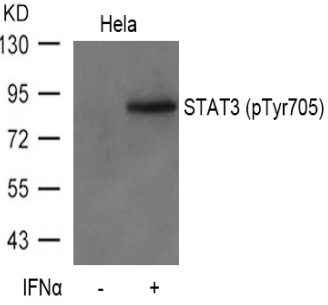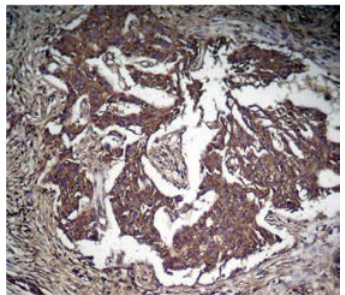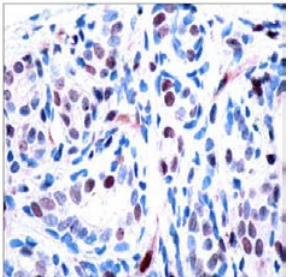Anti-STAT3 (phospho-Tyr705) Antibody (43045)
Data
 Immunoblot: Detection of STAT3 (phosphoTyr705) in extracts of HeLa cells
treated or untreated with IFNα.
Immunoblot: Detection of STAT3 (phosphoTyr705) in extracts of HeLa cells
treated or untreated with IFNα. - -
- -
Antibody DetailsProduct DetailsReactivity Species Human ⋅ Mouse ⋅ Rat Host Species Rabbit Immunogen Peptide sequence that includes phosphorylation site of tyrosine 705 (A-P-Y(p)-L-K) derived from human STAT3 and conjugated to KLH. Product Concentration 1.0 mg/ml Formulation PBS (without Mg2 and Ca2 ), pH 7.4, 150mM NaCl, 0.02% sodium azide and 50% glycerol. State of Matter Liquid Product Preparation Affinity-purified on phosphopeptide; non-phosphopeptidereactive antibodies were removed by chromatography on non-phosphorylated peptide Storage and Handling This antibody is stable for at least one (1) year at -20°C. Country of Origin USA Shipping Next Day 2-8°C Applications and Recommended Usage? Quality Tested by Leinco Immunoblotting: use at dilution of 1:500-1:1,000. A band of ~88kDa is detected.
Immunohistochemistry: use at dilution of 1:50-1:100. These are recommended working dilutions. End user should determine optimal dilutions for their applications. Each investigator should determine their own optimal working dilution for specific applications. See directions on lot specific datasheets, as information may periodically change. DescriptionSpecificity Rabbit Polyclonal Antibody specific to STAT3 (phospho-Tyr705) Background Signal transducers and activators of transcription (STATs) are transcription factors that play important roles in signaling pathways induced by many different cytokines and growth factors that regulate cell growth and differentiation, the immune response, antiviral activity, and homeostasis. Their activation and mechanisms of action are examples of direct signaling to the nucleus by extracellular polypeptide ligands without the involvement of second messengers, tyrosine phosphorylation of transcription factors, or transcription factors that make direct contact with membrane-bound receptors and DNA. Since the discovery of STAT 1 and 2, the family has been expanded to seven members. Antigen DetailsFunction Signal transducer and transcription activator that mediates cellular responses to interleukins, KITLG/SCF, LEP and other growth factors (PubMed:10688651, PubMed:12359225, PubMed:12873986, PubMed:15194700, PubMed:17344214, PubMed:18242580, PubMed:23084476). Once activated, recruits coactivators, such as NCOA1 or MED1, to the promoter region of the target gene (PubMed:17344214). May mediate cellular responses to activated FGFR1, FGFR2, FGFR3 and FGFR4 (PubMed:12873986). Upon activation of IL6ST/gp130 signaling by interleukin-6 (IL6), binds to the IL6-responsive elements identified in the promoters of various acute-phase protein genes (PubMed:12359225). Activated by IL31 through IL31RA (PubMed:15194700). Acts as a regulator of inflammatory response by regulating differentiation of naive CD4(+) T-cells into T-helper Th17 or regulatory T-cells (Treg): deacetylation and oxidation of lysine residues by LOXL3, leads to disrupt STAT3 dimerization and inhibit its transcription activity (PubMed:28065600). Involved in cell cycle regulation by inducing the expression of key genes for the progression from G1 to S phase, such as CCND1 (PubMed:17344214). Mediates the effects of LEP on melanocortin production, body energy homeostasis and lactation (By similarity). May play an apoptotic role by transctivating BIRC5 expression under LEP activation (PubMed:18242580). Cytoplasmic STAT3 represses macroautophagy by inhibiting EIF2AK2/PKR activity (PubMed:23084476). Plays a crucial role in basal beta cell functions, such as regulation of insulin secretion (By similarity). {UniProtKB:P42227, PubMed:10688651, PubMed:12359225, PubMed:12873986, PubMed:15194700, PubMed:17344214, PubMed:18242580, PubMed:23084476, PubMed:28065600}. NCBI Gene Bank ID UniProt.org Research Area Phosphospecific Antibodies References & CitationsTechnical Protocols |




